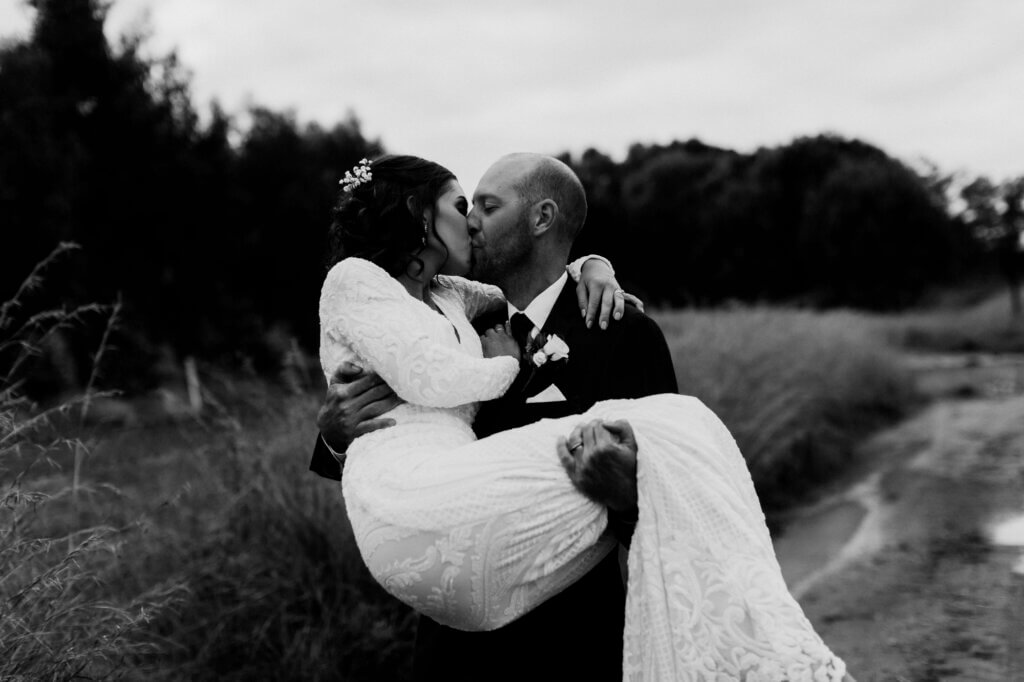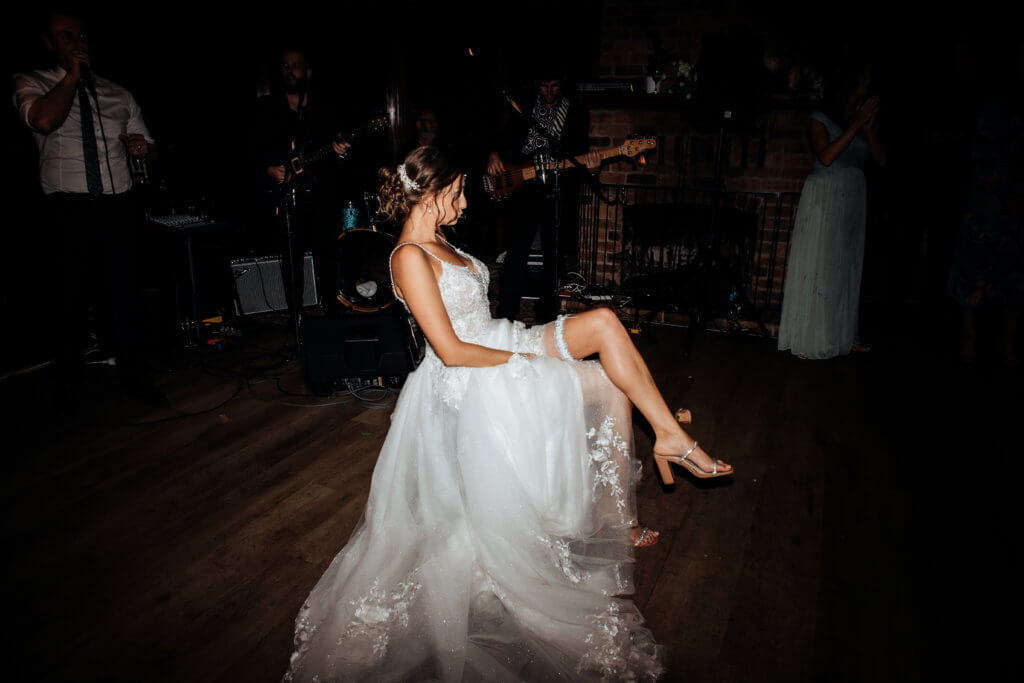The History And Meaning Behind These 6 Common Wedding Traditions

Brides traditionally wear a veil and a white wedding dress – but have you ever stopped to think about why that is?
One thing I find so fascinating is the history of wedding traditions. Many of our cultural wedding traditions have been happening for hundreds of years, with many couples still following them today. However, it’s worth taking the time to think about how they came to be.
Many of the couples I photograph plan modern, dynamic weddings, but often incorporate tradition into their day as well. Of course, both traditional weddings and modern weddings are awesome – it all just comes down to your personal preferences.
For couples starting to plan their wedding, here’s a look at the history behind wedding traditions. Some traditions have changed their meaning over time, but are still so ingrained in our society that it’s worth understanding them a bit more!


1. The white wedding dress
If you walk into just about any wedding store in Western society, it will be overflowing with white dresses! So the question is… Why?!
While the colour white is usually associated with traditionally conservative ideas of ‘purity’ and ‘chastity’, the original meaning was actually much more shallow: flexing your wealth. Queen Victoria wore a white court dress to her wedding with Prince Albert in 1890 and the trend spread from there. Because laundry day was a real mission back in Victoiran times, wearing an expensive white gown that could be easily ruined by the slightest errant spill or smudge was seen as an impressive show of YOLO wealth. Before this, red was the favoured colour in Europe and the whole rainbow was up for grabs in America.
Back to the idea of ‘chastity’. There was a time when brides were expected to be virgins on their wedding day and wearing white became a symbol of this purity – particularly in America. We now live in a society where women aren’t measured by their chastity, and most modern couples live together before marriage.
Brides may choose to wear white for both tradition and fashion, but the dresses no longer have that strong symbolism attached to them. If you want to wear white, amazing – but if you don’t, you can wear whatever you like!
You might have also heard about the colour blue on wedding days – so why do brides wear something blue? This comes from the old poem about brides wearing ‘something borrowed and something blue’. The borrowed item represents good luck, while the blue colour symbolises loyalty.


2. Garter belts
Why do brides wear a garter belt? This is a piece of lacy lingerie that goes just above the knee – tradition states the groom should remove the garter belt (often using his teeth!) at the reception and toss it out into the crowd, and whoever catches it is next to be married.
Here’s the thing, though… The removal of the garter belt is meant to represent the consummation of the marriage. So if you don’t want your grandparents and relatives imagining you and your partner on your honeymoon, then it may not be for you!! Personally, I used to find it quite inappropriate, however recently I have had a few couples get very creative with it and it’s been a lot of fun – well worth any embarrassment.
How to get creative with the Garter Toss!!
Here are some Creative Ideas!
The garter toss is the male equivalent to the bouquet toss. Traditionally it is taken off by the groom with his teeth! in front of everyone, to represent the consummation of marriage. It can be deemed quite inappropriate if not done well! That said, in my experience if you’re into a night of party games on your wedding, and nothing is taken too seriously then this may be for you!!
In recent times, I have experienced couples getting very creative with this. Here are some ideas…
- Dance off!!
Get all the single men under 40 to pair up and start dancing. The mothers of the bride and groom are the judges. Narrowed down until a winning couple is left, then they have to dance against each other. Put on a variety of genres of music to check for versatility!! The winner is the lucky man!




2. Challenge by the groom.
The groom decides to challenge any willing candidates by getting them to getting them to do reps of sit-ups, press-ups or if you’re dealing with a really fit bunch – burpees. The fittest guy wins. Mother of the bride watches on to check there is no funny business!! This game could be altered by adding challenges that are less demanding on the body. Maybe a little quiz… again this is something you can get creative with!





3. Cake cutting
Ah, the delicious wedding cake. Let’s be honest – cake tasting is one of the most fun elements of wedding planning! However, it really only takes one person to slice a cake, so why is this something couples do together on their wedding day?
This tradition represents unity, with the joint act of slicing the cake the first task you do together as a married couple. That’s pretty sweet! There’s also a tradition where the couple feeds each other some cake, then smashes more of said cake on each other’s faces. The act of feeding one another cake is supposed to represent your commitment to each other, but as for the cake-smashing… It’s an easy way to mess up your gorgeous wedding gown, so if you choose to do it, be careful!

4. Bouquet toss
Speaking of reception traditions: do brides still throw the bouquet? Yes, this custom is still pretty common. The origins of this one are about luck. Brides were once considered ‘lucky’, so if you could get something belonging to the bride, it was said to bring you good luck. The custom originally said that whoever caught the bouquet was likely to be the next person to get married, but nowadays, it’s more just about having fun with your bridal party.
If you don’t buy into the superstition, then we can take a look even further back. The whole ‘no sex before marriage’ rule of yesteryear meant the bride and groom were usually pretty eager beavers to get down on the day. The bridal toss was used as a distraction to get some immediately after the ‘I dos’, while the guests fought over the lucky florals.
While we’re on this – what’s the history behind the wedding party itself? There are a lot of origin stories around bridesmaids and groomsmen, but in ancient Roman times, ten witnesses were required to be present at each wedding. Later, the bridal party came to offer emotional support and even safety (sounds much tougher than just planning a hen’s night!).
In fact! If you’ve ever wondered why bridesmaids are all required to wear matching dresses, the answer lies in misdirection. Bridesmaids acted as doppelgangers to the bride on the day of her wedding to confuse angry exes hunting for a dowry that should have been theirs or vengeful spirits looking to cause a fracas. They went so far as to form a protective shield around the bride-to-be as they made their journey to the groom’s village.
Here’s a hint: between speeches, bouquet tosses, and dancing, there’s plenty to think about with your reception, so it helps to be organised with a wedding timeline that gives you a thorough plan for your day.

5. Bridal veils
It’s still pretty common for brides to wear veils – they look elegant and are beautiful to photograph, but they actually represent (again!) purity, modesty, and chastity. The ‘unveiling’ of the bride represented a woman passing from her father to her husband.
However, in modern times, this can simply be a sweet moment between father and daughter and doesn’t need to mean anything else. Or why not lift your own veil? I love seeing couples create fun wedding traditions themselves!


6. The groom not seeing the bride until she walks down the aisle
Most couples get ready with their bridal party the morning of the wedding, with tradition stating that a groom shouldn’t see his bride until she walks down the aisle.
The origins of this one are a little hard to imagine nowadays. This tradition stems back to the days when couples were betrothed before meeting each other. They met for the first time at their wedding so they didn’t have an opportunity to back out!
These days, it’s more about the fun of getting ready and spending time with your awesome bridal party, and then surprising the groom with your absolutely stunning wedding look.



7. The best man
Best man, best friend, best bro, best… fighter? Runaway brides and difficult in-laws were the original reason for the ‘best man’, who were tasked with catching cold-footed escapees or even going so far as to kidnap the betrothed if the bride’s parents didn’t approve.
That’s before we even get to fighting off enemies and rival lovers during the ceremony. These days, a good sense of humour and remembering the rings is all that’s usually required of these former warriors.

Who knew there was so much meaning behind common wedding traditions? When I work with my couples, I love hearing all about your unique and meaningful family wedding customs, giving each wedding its own gorgeous flair. If you’re planning a modern or traditional wedding in South West Australia, let’s have a chat about your wedding photography needs – I’d love to help bring your beautiful plans to life!
COMMENTS
« Shazz & Tara’s Fun Country Festival Wedding in Boyup Brook
A Quintessential Bridgetown Country Wedding »